.png)



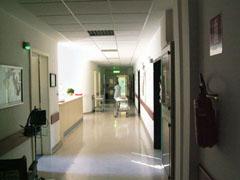
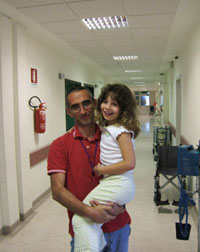
Our daughter Martina turned seven in September 2006. We celebrated her birthday with a complete change in her (and our) life. She had just been desensitized from a life-threatening allergy to milk.
Martina has been allergic to milk since she was a baby: the very first time that we tried to feed her powdered milk she got hives all over her little body. She was diagnosed with a milk allergy, and her pediatrician recommended a strict exclusion diet, hoping that she would outgrow the allergy in time. But she did not.
In the following years Martina had a few accidental contacts with traces of milk, which were followed by progressively worse
reactions. We took all the precautions that are usually recommended to parents of kids with life-threatening allergies:
we learned to read between the lines of huge labels with microscopic print, we avoided most restaurants (and when we went we
badgered waiters and cooks to show us the ingredient labels of hamburger buns, bread crumbs, salad dressing, etc.), we replaced
birthday cakes and treats with our favorite healthy (dairy free) foods, and we carried an Epipen adrenaline auto-injector wherever we went.
Despite our best efforts, and despite Martina's complete cooperation, there were several accidental exposures to milk that finally led to the
emergency room. Once, for example, at a gathering of friends someone made her "dairy free shirley temple" but accidentaly stirred it
with a spoon that had previously been used to stir a drink containing milk. Another time we walked into a coffee shop and she
became sick just from being exposed to the steam that came off of a cappuccino machine.
Of course Martina felt different from theother kids: she could not join pizza parties, she never took part in bake sales at school, she couldn't even
decorate Halloween cupcakes. We tried to do our best to make her feel normal, but it wasn't always easy, and the other "healthy" kids were not always
very sympathetic; even some of her friends' parents felt uneasy about the responsibility they'd have to assume if they invited
her over.
Every other year, we had Martina's allergy tested, and the result was always the same: class VI, the highest possible. We became members of the Food Allergy and Anaphylaxis Network, and every once in a while we contacted a new doctor, but we always got the same answer: "There is no possible cure to life-threatening food allergies. The only strategy is avoidance."
Finally last year we read an article in the Italian medical magazine "Medico e Bambino" describing the work carried out by the Pediatric Hospital Burlo Garofolo in the city of Trieste, north-east of Italy (www.burlo.trieste.it).
The hospital has been performing oral desensitization therapy to treat food allergies since 1995, with very encouraging success rates: Out of some 200 children who have undergone the treatment, 60% have left the hospital on an unrestricted diet; 30% presented some level of tolerance at the time of dismissal and were able to arrive at an unrestricted diet after approximately one year of treatment at home. Only 10% of the children were not able to complete the treatment, usually because their reactions were too severe, (sometimes included acute gastritis) and they were considered too young to risk continuing the treatmemnt.
Allergies treated at the Burlo Garofolo include milk, egg and wheat, which are the most common food allergens in Europe. So far, the hospital has not treated kids allergic to peanuts.
The treatment consists of progressive oral administrations of the allergen, starting with infinitesimal quantities and increasing the dose every two hours (5 to 3 doses daily). Antihistamine is given twice a day, and an iv catheter is maintained on the patient for the duration of the treatment, so that adrenaline can be administered without delay in case of an emergency. The treatment lasts about 10-12 days, and is later continued at home following a sequence determined by the hospital.
Martina entered the hospital on July 3rd, 2006. Since we were travelling from the United States, the doctors
suggested extending the period of treatment to 14 days, to make sure that she would leave the
hospital with a level of tolerance high enough to guarantee safe continuation at home. She was
dismissed on July 17th, 2006.
The table that follows shows the treatment undergone by Martina, and the reactions that she presented
to each dose:




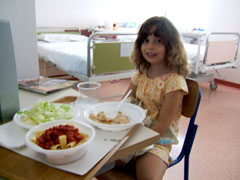
Upon being discharged form the hospital, the doctors recommended that we continue the treatment at home for 1 year, according to the following directions:
Two months after dismissal from the Hospital Martina was able to drink two cups of milk (200cc each) per day (that is almost a pint per day!). She has been able to taste ice cream, pudding, yogurt and cheese, and she eats cookies and dairy snacks on a regular basis. By the way, she loves them! She has had minor reactions several times (mostly rhinitis) that we treated with antihistamine and albuterol. We are still very cautious not to exceed her tolerance levels, especially with cheese, in which casein, the offending protein in cow's milk (and in goat's milk!), is highly concentrated, but she is doing better every day, and we feel less and less worried.


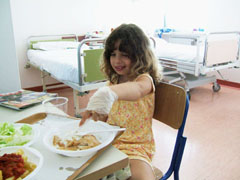
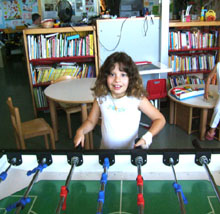
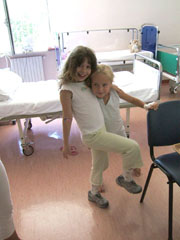
The Pediatric Hospital Burlo Garofolo is a public hospital, which means that it is totally funded
by the Italian Government. The treatment and stay are free of charge for Italian citizens and residents.
I was told that the cost would be around $5,000 for non-Italians.
The building looks a little old from outside, but the facade is being restructured, and shady gardens
add a pleasant touch to the place.
The unit in charge of the desensitization allergy therapy is called the "Pediatric Clinic". It is directed by Prof.
Alessandro Ventura, a talented doctor and manager with an open-minded approach. All the doctors and
staff are great! They are gentle and professional, always available and very good with children.
Additionally, most of them speak some English. We want to express our special thanks to Dr. Egidio Barbi,
who is efficiently in charge of the Clinic coordination, and to Dr. Stefania Norbedo, who personally
followed Martina's progress with contagious enthusiasm.
The hospital rooms have two or three beds each and a private bath with shower. They are ample and very clean.
One of the parents is allowed to spend the night with the child and, if coming from out of town, is
usually offered a bed in the same room, as long as the Unit is not full. When we enrolled Martina in this program,
we were promised a room with two beds, one for Martina and one for myself (the mom), but as soon as we got there
an emergency arose and they had to give my bed to another patient. Fortunately, the staff could
arrange to add a third bed in our room, so that I had a place to sleep. But yes, there are times when a parent
has to share the bed with their kid, or sleep on an armchair. Some parents prefer to spend the nights in a pension
located less than a block from the hospital, though this would be less adviseable if the patient is very young.
Within the grounds of the hospital there is a guesthouse to house the "other" parent in cases where both parents have
traveled with the patient. It has double bedrooms (so you may have to share), a kitchen, living room and laundry.
Bathrooms are "down the hall" but they are clean and there are many of them so that one never has to wait. Since the
rooms in this guesthouse are available at no cost (a tip, however, is gladly accepted by the managers), it is a good idea
to book early.
The Pediatric Clinic has a playroom with games, TV and DVD player, and a library. Every morning and afternoon,
the kids are entertained by volunteers, who even offer some baby-sitting to parents in need of a little
rest. My husband and I took advantage of their offer and were able to have lunch together at the hospital cafeteria
several times (otherwise we'd be taking turns). Meals at the hospital cafeteria are 5 Euro each, nothing special, but abundant and healthy.
To eat there you must buy meal tickets at a "hole in the wall" bank in the building next door.
A computer room with broadband Internet access and a library are conveniently located just nextdoor to the Pediatric
Clinic, parents are allowed to use these resources free of charge.
Two hours after the last milk ingestion, if no allergic reaction has occurred, kids are allowed to
leave the Hospital premises with their parents. A mall is located 5 minutes walk away, and buses take
only 10 minutes to arrive in downtown Trieste.
After 14 days in the Hospital, we were all tired and wishing to go back home, but most of all, we were grateful and happy that the treatment had worked. Martina's life has changed. We are so proud of our little Martina. We are proud of how patiently she coped with the threat of her food allergy as well as the difficulty of being different from other children. How bravely she faced those 14 days in the hospital! Now we look towards the future with confidence and hope. Thank you Burlo Garofolo, for making it possible.
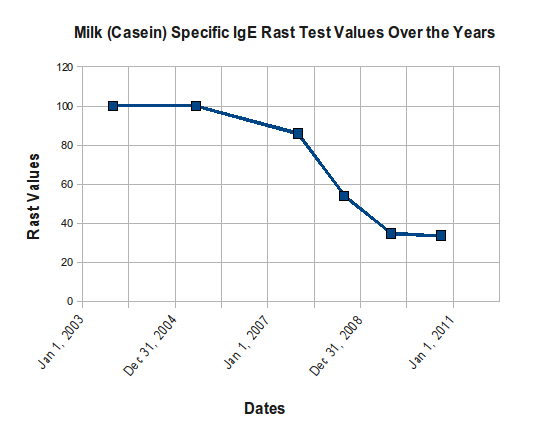
If you would like to have additional information, you may contact me at allergyhope@gmail.com